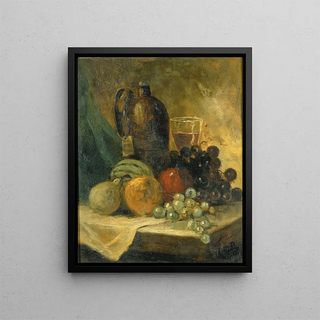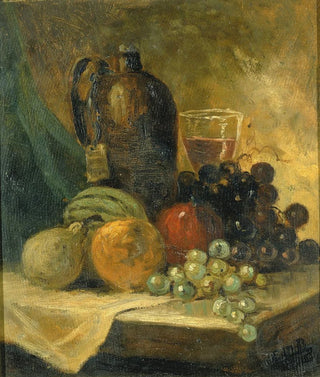Art print | Still life - Edward Mitchell Bannister


View from behind

Frame (optional)
Nature morte art print - Edward Mitchell Bannister – Captivating introduction
Edward Mitchell Bannister's art print evokes a delicate harmony between the beauty of everyday objects and the emotion that their representation can inspire. This piece, imbued with sensitivity, transports us into a universe where light dances on surfaces, revealing textures and colors in a way that captivates the eye and the mind. Bannister, a master painter, uses his palette with such finesse that each element of the composition seems to tell a story. As you contemplate this work, the viewer is invited to reflect on the relationship between art and life, on the passage of time, and on the fleeting nature of beauty.
Style and uniqueness of the work
Bannister's style is distinguished by an impressionist approach that transcends simple representations of nature morte. The play of light and shadow, as well as subtle nuances of color, give the work an almost tactile dimension. Every fruit, every vase, every reflection is treated with meticulous care, inviting the viewer to explore the details. The composition, although classic in its arrangement, reveals a modernity in the way objects are juxtaposed, creating a visual balance that captures attention. Bannister does not merely reproduce reality; he interprets it, transforms it, and manages to infuse soul into his inanimate subjects. Thus, this nature morte becomes a living painting, where the viewer can almost feel the sweetness of a peach or the freshness of a flower.
The artist and his influence
Edward Mitchell Bannister, an emblematic figure of the 19th-century American art movement, established himself through his talent and unique vision. As an African-American painter, he had to overcome many obstacles in a often closed art world. Yet, his determination and commitment to art allowed his work to shine. Bannister drew inspiration from nature, but also from the challenges of his time, seeking to establish a dialogue between his identity and his art. His influence is felt not only through his own creations but also through a generation of artists who followed his example. By incorporating elements of African-American culture into his works, he paved the way for greater diversity in the landscape

Matte finish

View from behind

Frame (optional)
Nature morte art print - Edward Mitchell Bannister – Captivating introduction
Edward Mitchell Bannister's art print evokes a delicate harmony between the beauty of everyday objects and the emotion that their representation can inspire. This piece, imbued with sensitivity, transports us into a universe where light dances on surfaces, revealing textures and colors in a way that captivates the eye and the mind. Bannister, a master painter, uses his palette with such finesse that each element of the composition seems to tell a story. As you contemplate this work, the viewer is invited to reflect on the relationship between art and life, on the passage of time, and on the fleeting nature of beauty.
Style and uniqueness of the work
Bannister's style is distinguished by an impressionist approach that transcends simple representations of nature morte. The play of light and shadow, as well as subtle nuances of color, give the work an almost tactile dimension. Every fruit, every vase, every reflection is treated with meticulous care, inviting the viewer to explore the details. The composition, although classic in its arrangement, reveals a modernity in the way objects are juxtaposed, creating a visual balance that captures attention. Bannister does not merely reproduce reality; he interprets it, transforms it, and manages to infuse soul into his inanimate subjects. Thus, this nature morte becomes a living painting, where the viewer can almost feel the sweetness of a peach or the freshness of a flower.
The artist and his influence
Edward Mitchell Bannister, an emblematic figure of the 19th-century American art movement, established himself through his talent and unique vision. As an African-American painter, he had to overcome many obstacles in a often closed art world. Yet, his determination and commitment to art allowed his work to shine. Bannister drew inspiration from nature, but also from the challenges of his time, seeking to establish a dialogue between his identity and his art. His influence is felt not only through his own creations but also through a generation of artists who followed his example. By incorporating elements of African-American culture into his works, he paved the way for greater diversity in the landscape






